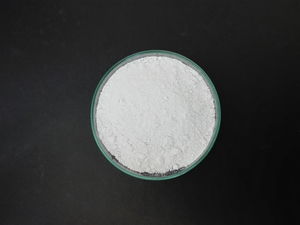Strontium carbonate
 Strontium carbonate in a Petri dish
| |
| Names | |
|---|---|
| IUPAC name
Strontium carbonate
| |
| Systematic IUPAC name
Strontium carbonate | |
| Other names
Strontianite
| |
| Properties | |
| SrCO3 | |
| Molar mass | 147.63 g/mol |
| Appearance | White solid |
| Odor | Odorless |
| Density | 3.74 g/cm3 |
| Melting point | 1,494 °C (2,721 °F; 1,767 K) (decomposes) |
| Boiling point | Decomposes |
| 0.0011 g/100 ml (18 °C) 0.065 g/100 ml (100 °C) | |
| Solubility | Reacts with acids Soluble in aq. ammonia and aq. NH4Cl, carbonated water |
| Vapor pressure | ~ 0 mmHg |
| Hazards | |
| Safety data sheet | Sigma-Aldrich |
| Flash point | Non-flammable |
| Related compounds | |
| Related compounds
|
Magnesium carbonate Calcium carbonate Barium carbonate |
| Except where otherwise noted, data are given for materials in their standard state (at 25 °C [77 °F], 100 kPa). | |
| Infobox references | |
Strontium carbonate is a common strontium compound with the chemical formula SrCO3. It is often used in pottery, and can be obtained cheaply from such suppliers.
Contents
[hide]Properties
Chemical
Strontium carbonate is similar to all carbonates in that it reacts with most acids to produce the corresponding strontium salt, carbon dioxide, and water. Thus it is likely the most-used intermediate for strontium salts. Care must be taken when this is done with pottery grade material, as this is often contaminated with strontium sulfide which will produce hydrogen sulfide when mixed with a strong acid. It can be purified by reacting with a weak, soluble strontium salt making acid and filtering of insoluble powders. Strontium carbonate will also decompose at 1494°C to strontium oxide.
Physical
Strontium carbonate, when obtained from pottery suppliers, is an odorless white powder which is insoluble in water and soluble in acids.
Availability
Strontium carbonate is readily available at a cost of $2-3 per pound from pottery suppliers.
Many lab suppliers also sell strontium salts, including strontium carbonate.
Preparation
This compound can be prepared from a metathesis reaction between a soluble strontium salt, such as strontium nitrate, and an alkali carbonate such as sodium carbonate. Strontium oxide or hydroxide left in air will slowly convert to the carbonate in the presence of carbon dioxide.
Projects
- Producing other strontium salts
- Strontium nitrate or strontium chlorate for flash powder or red road flares
Handling
Safety
Strontium is nontoxic, however large amounts of strontium in the body may lead to strontium replacing calcium in the bones. It is not known whether this has detrimental health effects, since low amounts of strontium are relative harmless.
Storage
Should be stored in closed bottles.
Disposal
No special disposal is required, as it is non-toxic.